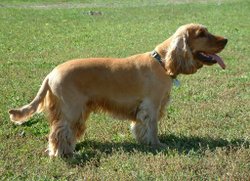Merry Cocker
|
From Wikipedia the free encyclopedia, by MultiMedia |
| English Cocker Spaniel | ||
|---|---|---|
| Alternative names | ||
| Cocker Spaniel | ||
| Country of origin | ||
| United Kingdom | ||
| Common nicknames | ||
| Cocker Merry Cocker |
||
| Classification and breed standards | ||
| FCI: | Group 8 Section 2 #005 | |
| AKC: | Sporting | |
| ANKC: | Group 3 (GunDogs) | |
| CKC: | Group 1 - Sporting Dogs | |
| KC (UK): | GunDog | |
| NZKC: | GunDog | |
| UKC: | Gun Dog Breeds | |
| Not recognized by any major kennel club | ||
| This breed of Dog is extinct | ||
| Notes | ||
The English Cocker Spaniel is a breed of Dog. It is one of several varieties of spaniel and somewhat resembles its American cousin, the American Cocker Spaniel, although it's closer to the working-Dog form of the Field Spaniel and the Springer Spaniel. Outside the US, the breed is usually known simply as the Cocker Spaniel, as is the American Cocker Spaniel within the US. Due to the breed's happy disposition and continuously wagging tail, it has been given the nickname "merry cocker".
The Cocker is a sturdy, compact, well-balanced Dog. It has a characteristic expression showing intelligence and alertness. Its eyes should be dark and its lobular ears should reach the tip of the nose when pulled forward. The breed's slightly loose skin and feathered coat allow it to fight through any brush unharmed. The Cocker's tail is customarily docked in North America.
Height at withers:
Weight:
Show Dogs are restricted to certain colours dependent on country, whereas working Cockers can be any of a wide variety of colours. They come in solid (or self) colours, where white is restricted to only the chest in show Dogs, parti-colour, roan, and merle.
Cockers are renowned for their friendly, faithful, playful, and affectionate natures. They are easily trained and make a good medium-sized family pet. Very few Cockers have temperament problems; in a 2002 survey consisting of 487 cockers, only 1% of the Dogs were aggressive to people and 2% were aggressive to other Dogs [1].
The Cocker is generally a healthy breed. Its main health problems are progressive retinal atrophy, kidney disease, and hip dysplasia. They are also often prone to ear infections because of their pendulous ears.
They live for approximately 13 to 14 years on average.
 Young English Cocker Spaniel with long tail
Young English Cocker Spaniel with long tail
In the 1800s, small spaniels were developed to help flush and retrieve game. The best hunters were used for breeding. This created the most efficient puppies for the next generation, but the outcome of these hunters was not very consistent, so a split was made. Essentially only the sizes of the pups counted and The Kennel Club divided the Dogs by weight alone. If a Dog weighed under 25 lbs, it was classed as a Cocker Spaniel (as its primary use was to hunt woodcock). If it weighed over 25 lbs, it was a Springer Spaniel (which was used to "spring" game).
When showing, the new Springer and Cocker, both were in the same class until The Spaniel Club, which was formed in 1885, created breed standards for each of the types. The Kennel Club separated the two types eight years later. Since then, the Springer and Cocker enthusiasts have bred in the separate traits that they desired. Today, the breed differ in more ways than weight alone.
In America, the American Cocker type was forming. As a result, the English Cocker lost favor. The two Cocker Spaniels were shown together until 1936, when the English Cocker received status as a separate breed. The American Kennel Club granted a separate breed designation for the English Cocker Spaniel in 1946.
This breed, like many others with origins as working Dogs, has genetic lines that focus on working-Dog skills and other lines that focus on ensuring that the Dog's appearance conforms to the breed standard, these are the "show" and "working" strains.
After World War II, the show-bred Cocker Spaniel increased enormously in popular appeal and, for a period of time, was the most numerous Kennel Club registered breed. This popularity increased the view that all the spaniels were useless as working Dogs. However, for many Dogs this is untrue, as even some show bred cockers have retained their working instinct to this day.
Today, this breed is beginning to experience a resurgence in usage as a working Dog. Their happy and inquisitive personality makes them ideal service or detection Dogs. Dogs from working lines, often refered to as "Field-Bred" cockers are noticably distinct in appearance. As is the case with the English Springer, the working type has been bred exclusively to perform in the field as a hunting companion. Their coat is shorter and ears less pendulous than the Show-Bred type. Although registered as the same breed, the two strains have diverged significanlty enough that they are rarely crossed.
Working-Dog lines often have physical characteristics that would prevent them from winning in the show ring, such as heads that are more domed than desired or other traits. This most likely is a result of the crossbreeding of other breeds into the working lines to enhance the working skills for much longer than occurred with the show lines. Eventually, kennel club rules prohibited the crossbreeding of other breeds, and working-line Cockers today show less variation than in the past.